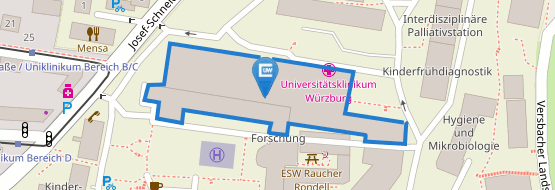A07 - Kuhn
Endothelial effects of atrial natriuretic peptide (ANP)
Summary
Cardiac atrial (ANP) and B-type natriuretic peptides (BNP) have important endocrine functions which maintain arterial blood pressure and blood volume homeostasis (1). Their common guanylyl cyclase A (GC-A) receptor is highly expressed in vascular endothelium and mediates endothelial increases of cyclic GMP, but the physiological role was unclear for a long time. Our observations in a genetic mouse model with a conditional endothelium-restricted deletion of the GC-A gene (EC GC-A KO) demonstrate that the vascular endothelial effects of ANP are critical for its hypotensive and hypovolemic functions. A loss of the endothelial effects leads to chronic arterial hypertension and hypervolemia already under normal salt conditions (2). Even more, the acute hypovolemic effects of ANP are completely abolished in EC GC-A KO mice (3). To analyze whether this hypervolemic hypertension is induced by changes in the microvascular endothelial permeability for albumin and in the transcapillary fluid exchange, we applied intravital microscopy to observe the murine microcirculation in dorsal skin folds and within the M. Cremaster. In both models ANP provoked significant increases in the postcapillary extravasation of FITC-albumin. This effect was completely abolished in mice with global or endothelial-restricted GC-A deletion (3). Lastly, because published in vitro studies have shown that ANP modulates the release of the vasoactive factors nitric oxide (NO) and endothelin-1 (ET-1) we also examined whether alterations of these factors contribute to hypertension in EC GC-A KO mice. The vascular and tissue expression levels of components of the NO system and of immunoreactive ET-1 were not different in control and EC GC-A KO mice. Also, the vascular and blood pressure responses to these systems were similar (4). We conclude that the endothelium, but not modulation of endothelial NO or ET-1, participates in the acute and chronic regulation of arterial blood pressure by ANP. In fact, modulation of transcapillary protein and fluid transport may represent one of the most important hypovolemic and hypotensive actions of ANP.
Observations on cultured microvascular endothelial cells suggested that ANP and BNP not only modulate endothelial permeability but also stimulate proliferation and migration of endothelial cells. To elucidate whether the endogenous peptides participate in the modulation of postischemic angiogenesis we applied the model of hind limb ischemia. Notably, in mice with systemic deletion of the GC-A gene, vascular regeneration in response to critical limb ischemia was severely impaired. Similar attenuation of ischemic angiogenesis was observed in EC GC-A KO mice. In contrast, smooth muscle cell–restricted GC-A ablation did not affect ischemic neovascularization. Immunohistochemistry and RT-PCR revealed BNP expression in activated satellite cells within the ischemic muscle, suggesting that local BNP elicits protective endothelial effects. Since within the heart, BNP is mainly induced in cardiomyocytes by mechanical load, we investigated whether the natriuretic peptide/GC-A system also regulates angiogenesis accompanying load-induced cardiac hypertrophy. EC GC-A KO hearts showed diminished angiogenesis, mild fibrosis, and diastolic dysfunction. In vitro BNP/GC-A stimulated proliferation and migration of cultured microvascular endothelia by activating cGMP-dependent protein kinase I and phosphorylating vasodilator-stimulated phosphoprotein and p38 MAPK. We therefore conclude that BNP, produced by activated satellite cells within ischemic skeletal muscle or by cardiomyocytes in response to pressure load, regulates the regeneration of neighboring endothelia via GC-A. This paracrine communication might be critically involved in coordinating muscle regeneration/hypertrophy and angiogenesis (5).

